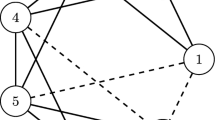Abstract
We study the performance of the dgsol code for the solution of distance geometry problems with lower and upper bounds on distance constraints. The dgsol code uses only a sparse set of distance constraints, while other algorithms tend to work with a dense set of constraints either by imposing additional bounds or by deducing bounds from the given bounds. Our computational results show that protein structures can be determined by solving a distance geometry problem with dgsol and that the approach based on dgsol is significantly more reliable and efficient than multi-starts with an optimization code.
Similar content being viewed by others
References
Aszódi, A., Gradwell, M.J. and Taylor, W.R. (1996), Protein fold determination using a small number of distance restraints, in: H. Bohr and S. Brunak (eds), Protein Folds, A Distance Based Approach (pp.85–97).
Blaney, J.M. and Dixon, J.S. (1994), Distance geometry in molecular modeling, in: CRC Press. K.B. Lipkowitz and D.B. Boyd (eds), Reviews in Computational Chemistry (pp.299–335), vol. 5, VCH Publishers.
Brünger, A.T. and Nilges, M. (1993), Computational challenges for macromolecular structure determination by X-ray crystallography and solution NMR-spectroscopy, Q. Rev. Biophys. 26: 49–125.
Crippen, G.M. and Havel, T.F. (1988), Distance Geometry and Molecular Conformation, John Wiley & Sons.
Engh, R.A. and Huber, R. (1991), Accurate bond and angle parameters for X-ray protein structure refinement, Acta Cryst. 47: 392–400.
Gautschi, W. (1994), Algorithm 726: ORTHOPOL-A package of routines for generating orthogonal polynomials and Gauss-type quadrature rules, ACM Trans. Math. Software20: 21–62.
Glunt, W., Hayden, T.L. and Raydan, M. (1993), Molecular conformation from distance matrices, J. Comp. Chem 14: 114–120.
Glunt, W., Hayden, T.L. and Raydan, M. (1994), Preconditioners for distance matrix algorithms, J. Comp. Chem 15: 227–232.
Golub, G.H. and van Loan, C.F. (1989), Matrix Computations, The Johns Hopkins University Press.
Guan, Y., Zhang, H., Konings, R.N.H., Hilbers, C.W., Terwilliger, T.C. and Wang, A.H.-J. (1994), Crystal structure of Y41H and Y41F mutants of gene V suggest possible protein-protein interactions in the GVP-SSDNA complex, Biochemistry33: 7768.
Havel, T.F. (1991), An evaluation of computational strategies for use in the determination of protein structure from distance geometry constraints obtained by nuclear magnetic resonance, Prog. Biophys. Mol. Biol. 56: 43–78.
Havel, T.F. (1995), Distance geometry, in Encyclopedia of Nuclear Magnetic Resonance, D.M. Grant and R.K. Harris, eds., John Wiley & Sons, 1995, pp. 1701–1710.
Hendrickson, B.A. (1991), The molecule problem: Determining conformation from pairwise distances, Ithaca, NY: Cornell University, Ph.D. thesis.
Hendrickson, B.A. (1995), The molecule problem: Exploiting structure in global optimization, SIAM J. Optimization 5: 835–857.
Hoch, J.C. and Stern, A.S. (1992), A method for determining overall protein fold from nmr distance restraints, J. Biomolecular NMR 2: 535–543.
Kostrowicki, J. and Piela, L. (1991), Diffusion equation method of global minimization: Performance for standard functions, J. Optim. Theory Appl. 69: 269–284.
Kostrowicki, J., Piela, L., Cherayil, B.J. and Scheraga, H.A. (1991), Performance of the diffusion equation method in searches for optimum structures of clusters of Lennard-Jones atoms, J. Phys. Chem.95: 4113–4119.
Kostrowicki, J. and Scheraga, H.A. (1992), Application of the diffusion equation method for global optimization to oligopeptides, J. Phys. Chem. 96: 7442–7449.
Kuntz, I.-D., Thomason, J.F. and Oshiro, C.M. (1993), Distance geometry, in: N.J. Oppenheimer and T.L. James (eds), Methods in Enzymology, vol. 177, pp. 159–204, Academic Press.
Le Grand, S., Elofsson, A. and Eisenberg, D. (1996), The effect of distance-cutoff on the performance of the distance matrix error when used as a potential function to drive conforma234 JORGE J. MOR´E AND ZHIJUN WU tional search, in: H. Bohr and S. Brunak (eds), Protein Folds, A Distance Based Approach, pp. 105–113, CRC Press, Inc.
Mairov, V.N. and Crippen, G.M. (1995), Size-independent comparison of protein threedimensional structures, Proteins: Struct. Func. Genetics22: 273–283.
Moré, J.J. and Wu, Z. (1995), "-optimal solutions to distance geometry problems via global continuation, in: P.M. Pardalos, D. Shalloway and G. Xue (eds), Global Minimization of Nonconvex Energy Functions: Molecular Conformation and Protein Folding, pp. 151–168, American Mathematical Society.
Moré, J.J. and Wu, Z. (1995), Global continuation for distance geometry problems, Preprint MCS-P505–0395, Argonne National Laboratory, Argonne, Illinois. Accepted for publication in the SIAM Journal on Optimization.
Moré, J.J. and Wu, Z. (1996), Smoothing techniques for macromolecular global optimization, in: G.D. Pillo and F. Giannessi (eds.), Nonlinear Optimization and Applications, pp. 297–312, Plenum Press.
Piela, L., Kostrowicki, J. and Scheraga, H.A. (1989), The multiple-minima problem in the conformational analysis of molecules: Deformation of the protein energy hypersurface by the diffusion equation method, J. Phys. Chem. 93: 3339–3346.
Scheraga, H.A. (1992), Predicting three-dimensionall structures of oligopeptides, in: K.B. Lipkowitz and D.B. Boyd (eds), Reviews in Computational Chemistry, vol. 3, pp. 73–142, VCH Publishers.
Skinner, M.M., Zhang, H., Leschnitzer, D.H., Guan, Y., Bellamy, H., Sweet, R.M., Gray, C.W., Konings, R.N.H., Wang, A.H.-J. and Terwilliger, T.C. (1994), Structure of the gene V protein of bacteriophage F1 determined by multi-wavelength X-ray diffraction on the selenomethionyl protein, Proc. Nat. Acad. Sci. USA 91: 2071.
Smith-Brown, M.J., Kominos, D. and Levy, R.M. (1993), Global folding of proteins using a limited number of distance constraints, Protein Engng. 6: 605–614.
Stroud, A.H. and Secrest, D. (1996), Gaussian Quadrature Formulas, Prentice-Hall, Inc.
Torda, A.E. and van Gunsteren, W.F. (1992), Molecular modeling using nuclear magnetic resonance data, in: K.B. Lipkowitz and D.B. Boyd (eds), Reviews in Computational Chemistry, vol. 3, pp. 143–172, VCH Publishers
Wu, Z. (1996), The effective energy transformation scheme as a special continuation approach to global optimization with application to molecular conformation, SIAM J. Optimization6: 748–768.
Author information
Authors and Affiliations
Rights and permissions
About this article
Cite this article
Moré, J.J., Wu, Z. Distance Geometry Optimization for Protein Structures. Journal of Global Optimization 15, 219–234 (1999). https://doi.org/10.1023/A:1008380219900
Issue Date:
DOI: https://doi.org/10.1023/A:1008380219900




